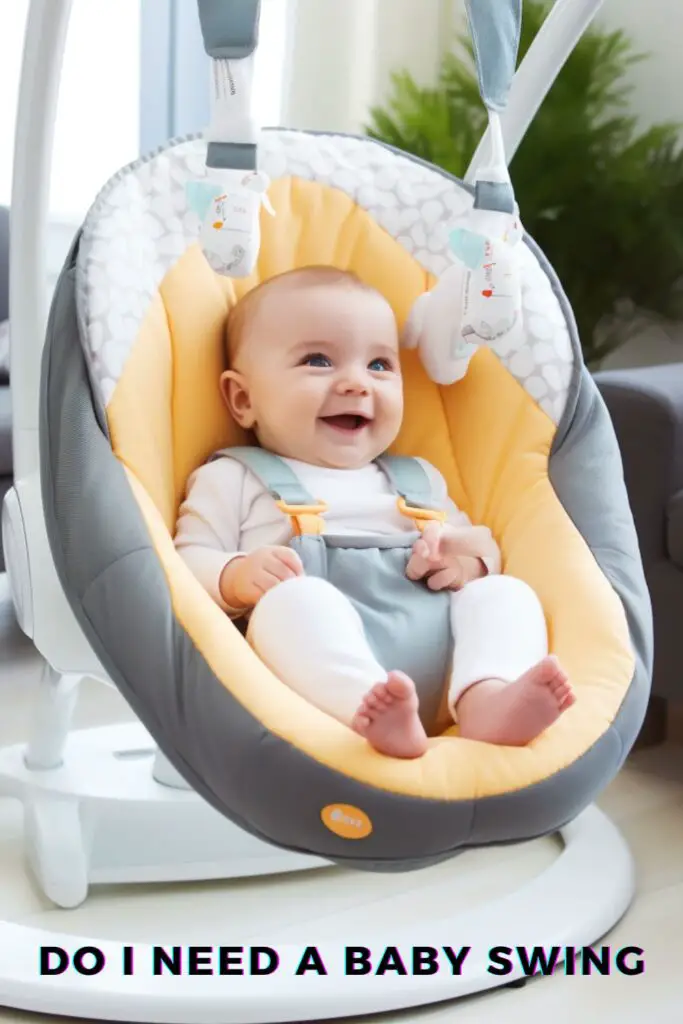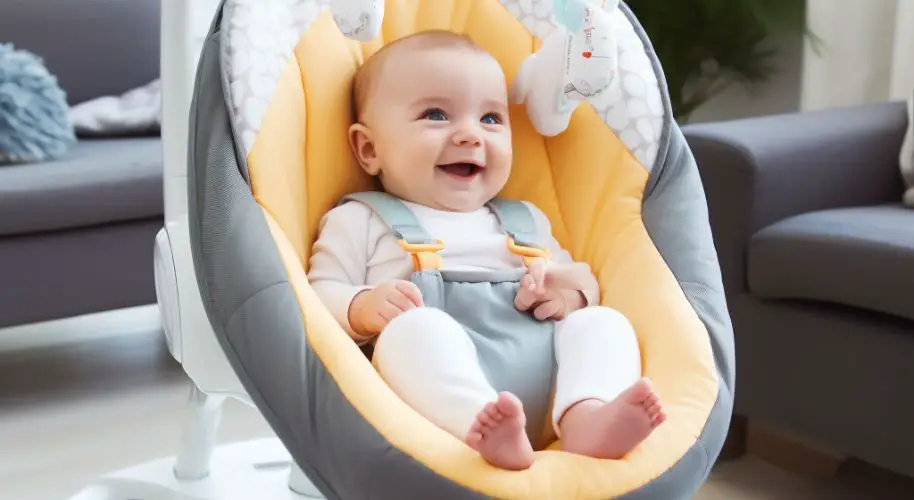Last Updated on June 5, 2025
Shopping for baby items can be overwhelming if you’re a new parent. So many products are designed to make life with your little one easier — but is a baby swing really necessary?
In this article, we’re here to help answer that question and provide you with tips on what type of swing to look for if you decide it is worth the investment.

Do I Need a Baby Swing?
When deciding whether or not a baby swing is worth the investment, there are several things to consider. First of all, will your little one benefit from it?
Swings can be great for soothing babies dealing with colic and provide entertainment for active little ones when you need to get a few things done.
On top of this, it helps you save energy since you don’t have to constantly be carrying your baby around or trying to entertain them.
As a mother, you know that baby wants constant attention and movement, but you can’t always give them that. A swing will help your little one get accustomed to self-soothing and still provide a form of motion.
Swings can provide comfort and entertainment for babies as long as they are used safely and correctly.
What Does a Baby Swing Do?
A baby swing is a device that helps soothe infants and give parents a break. It typically consists of a reclined oval-shaped seat attached to a base that moves back and forth, providing babies with comforting movement.
It mimics the natural soothing movements of a parent’s rocking and swaying, which increases calmness and promotes sleep. It can also provide entertainment by including toys on the swing that catch your baby’s attention.
Swings can also come with vibration, music, sounds, and adjustable speeds. They can be used both indoors and outdoors, depending on the model.
Additionally, most baby swings have weight limits that range from 20-40 pounds, so they can be used until the child is old enough to sit up on their own.
Exploring the Advantages of Using a Baby Swing
Baby swings can help settle infants and provide a comfortable place to relax. Here are some of the advantages of using a baby swing:
Comforting Motion – The back-and-forth movement of the swing can help settle a fussy baby and provide them with a sense of security.
Entertainment – Swings often come with features such as music, sounds, and toys to keep your baby entertained while in the swing.
Soothing Sounds – Many swings come with built-in sounds such as white noise, lullabies, and nature noises to help soothe your baby.
Convenience – Swings are great for parents who need a break from holding their babies all day. They provide a safe place for your baby to relax while you take care of other tasks.
Variety – There are many different types of swings on the market to meet your individual needs and preferences.
You Might also Like These Resources !
- Necessity of Baby Swings: Do You Really Need One?
- Impact of Prolonged Baby Swing Sleep on Spine Health
- Baby Swing Duration: Finding the Balance
What Should I Look For Before Buying A Baby Swing?

When shopping for a baby swing, it’s important to consider the important features of you and your little one. Here are some tips on what types of swings you should look for:
Age – Make sure to check the swing’s weight limit and choose one suitable for your baby’s age.
Safety – Always follow safety guidelines when using a baby swing, such as never leaving your baby unattended or allowing them to sleep in the swing.
Design – Consider the swing’s size, shape, and style to ensure it fits in with your home decor.
Features – Look for swings with music, vibration, reclining seats, and adjustable speeds to give your baby a comfortable experience.
The Pros and Cons of a Baby Swing
Before buying a baby swing, it’s important to understand its pros and cons.
Pros
- Baby swings provide a gentle rocking motion that can help soothe your baby and put them to sleep.
- Swings are an easy way to keep your baby entertained while you take care of other tasks around the house.
- Many swings include music, vibration, and lights that can further help entertain and relax your baby.
Cons
- Some babies may become too dependent on their swing for soothing or sleeping, making it harder for them to fall asleep without it.
- Swings should not be a substitute for supervised playtime or cuddle time with parents.
- Some swings have weight limits that may limit how long your child can use them safely.
Securing Safe Use of a Baby Swing
Certain precautions should be taken to ensure the safety of your baby:
- The most important factor when considering a baby swing is the weight limit. Most swings have an average maximum weight limit of 25 pounds, though some may exceed 40 pounds. It is important to check the manufacturer’s specifications before purchasing a swing for your baby, as exceeding the weight limit could cause damage or injury.
- In addition to weight limits, it is important to consider age limits when using a baby swing. Most swings are designed for babies from birth until they reach four months old or can sit up independently.
- It is not recommended that babies sleep in swings due to the risk of suffocation or strangulation, so it is best to transfer them into their crib once they fall asleep.
- Finally, ensure you read all instructions carefully before using the swing, and keep an eye on your baby at all times while they are in it. If you notice any signs of wear or tear, discontinue use immediately and contact the manufacturer for further instructions.
By following these simple guidelines, you can ensure your baby enjoys a safe and enjoyable time in their new swing!
Possibilities of Excessive Use
It’s important to know the potential dangers of excessive use. When used properly, baby swings can provide your little one with a safe and secure environment.
However, if used too often or too long, there is a risk of overstimulation and injury. Babies should never be left unattended in a swing, which can lead to falls or other accidents.
Also, babies should not be placed in a swing while sleeping, as this could cause them to become overheated or suffer positional asphyxia.
FAQs
Why do Infants Appreciate Swings?
Infants appreciate swings for many reasons. Swinging helps to stimulate the vestibular system, which is responsible for balance and coordination. It also helps to develop gross motor skills such as pumping legs, running, and jumping.
Additionally, swinging can help with fine motor skills such as grip strength and hand-eye coordination. Swinging can also provide enjoyment for babies while giving parents a break from holding their children.
Are Infants Allowed to Sleep in a Swing?
It is not recommended for infants to sleep in a swing. The American Academy of Pediatrics (AAP) advises against using swings for sleeping babies due to the lack of a firm, flat surface necessary for safe sleep.
Swings are known to lull babies to sleep, but moving them from the swing to a safe place if they fall asleep in the swing is important.
Additionally, infants have not developed muscles enough to hold up their heads and can easily fall out of the swing while sleeping.
Is There an Age Limit for Baby Swings?
Most baby swings have an age limit of 6 months, but these are just guidelines. Generally speaking, babies should only use a baby swing until they can support their head or sit up independently – usually at around 4 months old.
Wrapping Up
Baby swings can provide a safe and enjoyable environment for your little one to relax and have fun. It is important to be aware of the potential dangers associated with over-stimulation or excessive use, as well as potential risks such as overheating or positional asphyxia.
Follow the manufacturer’s age guidelines and watch your baby closely to ensure they are safe and comfortable in the swing. With proper use, baby swings can be a great way for your infant to enjoy quality time.
You Might Also Like These Latest Content !
- When Is the Right Time to Utilize a Baby Swing?
- Is There a Baby Swing Designed for Toddlers?
- Baby Congestion and Swing Sleeping: Safety Measures

Dr. Leah Alexander is a board-certified general pediatrician who has been in practice for over 20 years. She began working as a pediatrician at Elizabeth Pediatric Group of New Jersey in 2000. Since 2005, she has been working as an independently contracted pediatrician with Medical Doctors Associates at Pediatricare Associates of New Jersey. Read more
